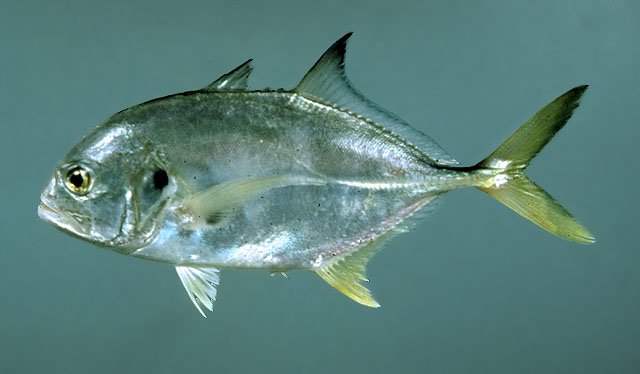| Carangidae (Jacks and pompanos), subfamily: Caranginae |
| 124 cm TL (male/unsexed); max.weight: 32 kg |
|
pelagic-neritic; brackish; marine; depth range 1 - 350 m, oceanodromous |
| Atlantic Ocean, restricted to continental shelf areas. Mediterranean excluded. |
|
Dorsal spines (total): 9-9; Dorsal soft rays (total): 19-22; Anal spines: 3-3; Anal soft rays: 15-18. Diagnosis: Scutes on lateral line 23 (Ref. 57392) to 42 (Ref. 13442). No scales on chest (Ref. 13442), except a small mid-ventral patch in front of pelvic fins (Ref. 13442, 57392). Upper profile of head steep (Ref. 13442). Maxilla ending approximately below (Ref. 13442, 57392) or beyond (Ref. 57392) posterior edge of eye (in adult). Front of soft dorsal and anal fins elevated; olivaceous to bluish green dorsally, silvery to brassy on the sides; prominent black spot posteriorly on gill cover at level of eye, another at upper axil of pectoral fins, and often a third on lower pectoral rays; caudal yellowish (Ref. 13442).
Description: body elongate (depth comprised 2.8-3.2 times in fork length) and moderately compressed; snout short; eyes with a well developed adipose eyelid; 2 dorsal fins, 1st with 8 spines, 2nd with 1 spine and 19-22 soft rays; anal fin with 2 spines, followed by 1 spine and 16-18 soft rays (Ref. 57392). Soft dorsal-fin lobe shorter than head length (Ref. 57392, 81654). Pectoral fins falcate, longer than head; scales small and cycloid; chest scaleless, except for a small, median-scaled patch in front of pelvic fins; posterior (straight) part of lateral line with 23-37 scutes; bilateral caudal keels present (Ref. 57392).
Coloration: back greenish to bluish or bluish-black, sides silvery-white to yellowish or golden; black spot on pectoral fins in adults; juveniles with about 5 crossbars on body (Ref. 57392).
|
| Generally in neritic waters over the continental shelf (Ref. 5217), from the coastline, where it is common on shallow flats, to offshore waters (Ref. 57392). Adults ascend rivers (Ref. 26938). Juveniles abundant in brackish estuaries with muddy bottoms, near sandy beaches and on seagrass beds (Ref. 5217), entering lagoons and lower courses of rivers (Ref. 57392). They form fast-moving schools, although larger fish may be solitary. They feed on smaller fish, shrimp, and other invertebrates (Ref. 5521). Often grunts or croaks are heard when caught. Eggs are pelagic (Ref. 4233). |
|
Least Concern (LC); Date assessed: 10 September 2018 Ref. (130435)
|
| reports of ciguatera poisoning |
Source and more info: www.fishbase.org. For personal, classroom, and other internal use only. Not for publication.
